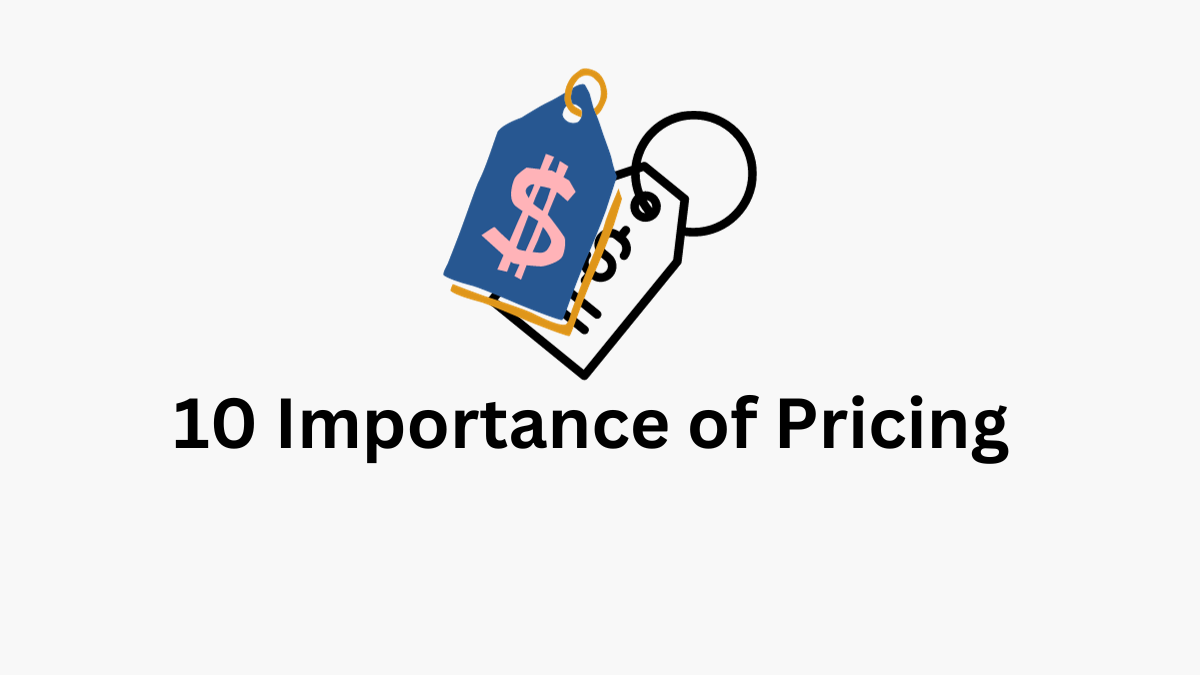Importance of Pricing
Pricing is the process of setting a price (value) of a product upon which it is exchanged between sellers and buyers. The following are the 10 major importance of pricing in marketing:
Revenue Generation
Pricing is the cornerstone of revenue generation in marketing. It’s not just setting a number; it’s crafting a financial strategy that ensures the cash flow necessary for a business’s survival and growth. By strategically aligning prices with market demand and customer willingness to pay, businesses can optimize their revenue streams.
Competitive Advantage
In the fiercely competitive market landscape, pricing serves as a powerful tool to gain a competitive edge. It’s the art of positioning a product or service in a way that makes it irresistible to consumers, giving them a compelling reason to choose your offering over others.
Effective pricing strategies, whether it’s offering lower prices, premium features, or unique value propositions, can create a distinctive brand identity. It’s about crafting a narrative that makes your product shine amidst a sea of alternatives.
Customer Perception
Pricing is intricately linked to how customers perceive a brand. It shapes their perception of the product’s quality, exclusivity, and overall value. A higher price tag can convey premium quality, while strategic discounts can create a sense of urgency and value.
Every price point sends a message to the consumers, shaping their expectations and influencing their purchasing decisions. It’s akin to painting a masterpiece, where each brushstroke (pricing strategy) adds depth and meaning to the final artwork.
Read More: Product Vs. Service: 10 Difference
Profitability and Sustainability
Behind every successful marketing campaign, there’s a well-calculated pricing strategy. Pricing isn’t merely about covering production costs; it’s about ensuring profitability and long-term sustainability.
By factoring in costs, market demand, and competitive analysis, businesses can establish prices that not only yield profits but also enable investments in innovation, expansion, and customer experience. It’s the financial backbone that ensures a business’s endurance and growth in the ever-evolving market landscape.
Strategic Marketing Tool
Pricing is a multifaceted strategic marketing tool that can be wielded to achieve a spectrum of objectives. Whether it’s penetrating new markets, maximizing short-term profits, enhancing brand image, or promoting customer loyalty, pricing strategies are the compass guiding marketing initiatives. It’s the pivot around which marketing campaigns revolve, allowing businesses to navigate market complexities and consumer behaviors effectively.
Read More: What is Service? Definition
Market Positioning
Pricing is a strategic lever that enables businesses to position themselves in the market effectively. It’s like choosing your spot on a crowded beach. By setting the right price, you can carve out your own space, whether it’s as a luxury provider, a budget-friendly option, or a value-driven brand. This positioning helps you stand out amidst the competition and attract the right audience.
Customer Segmentation
In marketing, not all customers are the same. Pricing allows you to tailor your offerings to different customer segments. It’s akin to offering different flavors of ice cream to cater to diverse tastes. By understanding the price sensitivity and preferences of various customer groups, you can create pricing strategies that resonate with each segment. This helps in building a loyal customer base and maximizing sales.
Innovation Incentive
Pricing can be a powerful incentive for innovation. When you set the right prices, it encourages your team to come up with new and improved products or services. It’s like a race where the prize (higher prices) goes to the most innovative. This drive for innovation keeps your business relevant and competitive in the ever-evolving market.
Read More: Product Mix Vs. Product Line
Pricing Psychology
In marketing, the psychology of pricing is a fascinating realm. It’s about understanding how consumers perceive prices and using that knowledge to influence their buying decisions. Think of it as the art of persuasion. Through techniques like charm pricing (e.g., $9.99 instead of $10) or bundling, you can nudge customers to make purchases and feel like they’re getting a great deal.
Adaptation to Market Changes
In our list of 10 pricing importance, helping adapt to market change is the last one. The marketing landscape is a dynamic, ever-changing terrain. Pricing provides the flexibility to adapt swiftly to market shifts. It’s akin to adjusting the sails on a boat to catch the changing winds. When market conditions evolve, you can tweak your pricing strategies to stay competitive, whether it’s responding to economic fluctuations, emerging trends, or competitive moves.
Read Next: What is Product Mix – Definition
Arti Kushmi holds a BBS (Bachelor in Business Studies) degree and shares her business and marketing knowledge through this website. While not writing she will be reading and enjoying the moment.
